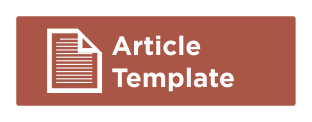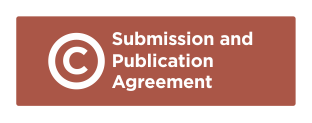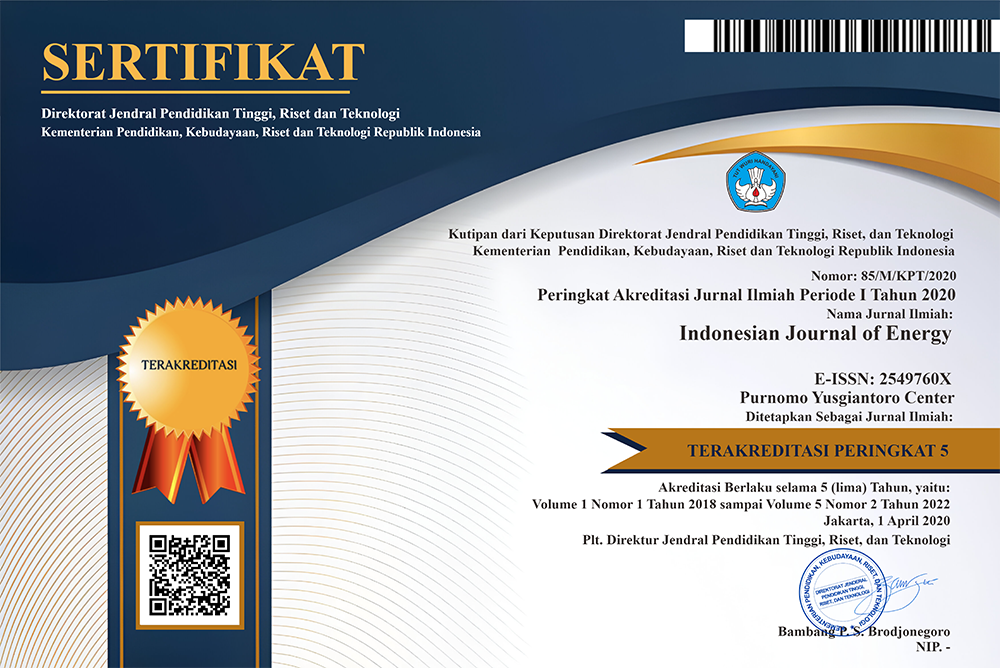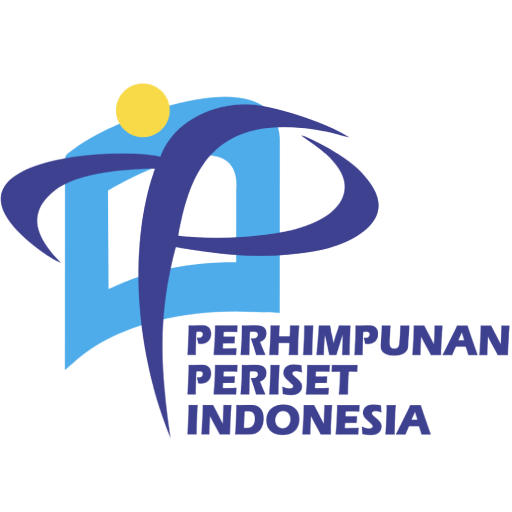Rethinking Energy Security in Indonesia from a Net Zero Perspective
Abstract
This study aims at examining in what way and to what extent Indonesia can safeguard its energy security from a net zero perspective. To achieve the objective of this study, the current and projected figures of three variables of the country’s energy system—the total emissions of Kyoto gases, CO2 emissions per sector, and primary energy mix—up to the end of the century were calculated. To shed light on these variables, IMAGE 3.2, an Integrated Assessment Model (IAM) was used. Three scenarios that include CurPol, NDC, and Glasgow were reviewed. This study found that the country's reliance on finite fossil fuels becomes unavoidable, potentially causing Indonesia to miss its net zero target while also being vulnerable to energy crises. It is found that neither strategy described in the country’s current policies nor in its NDC are in line with the country’s net-zero target.This situation is exacerbated by the fact that Indonesia has not enshrined its net zero target in law, leaving the country’s net zero commitment merely as a proposal rather than a pledge. Thus, if Indonesia is committed to ensure its energy security while also meeting its net zero target, it becomes imperative for the country to advance energy efficiency measures, incorporate carbon capture and storage (CCS) technology to control the emissions of ffossil fuels, and significantly increase the shares of renewables (solar and biomass in particular) to at least 50%in the country's primary energy mix.
Downloads
References
Boer, R. & Dewi, R. G. (n.d.). Indonesia NDC roadmap on AFOLU and energy sector. https://www-iam.nies.go.jp/aim/aim_workshop/aimws_25/presentation/6-01_Boer.pdf
Dowlatabadi, H. (1995). Integrated assessment models of climate change: An incomplete overview. Energy Policy, 23(4–5), 289–296. https://doi.org/10.1016/0301-4215(95)90155-Z
Climate Links. (2017, February 28). Greenhouse gas emissions factsheet: Indonesia. https://www.climatelinks.org/sites/default/files/asset/document/2017_USAID_GHG%20Emissions%20Factsheet_Indonesia.pdf
Climate Policy Database. (n.d.). Indonesia. https://climatepolicydatabase.org/policies/nationally-determined-contribution-ndc-113
Derbyshire, W., Mundiantoro, B., & Pranadi, D. (2021). Indonesia local content requirement review. Mentari. https://mentari.info/download/indonesia-local-content-requirement-review/
Dunne, D. (2019, March 27). The carbon brief profile: Indonesia. https://www.carbonbrief.org/the-carbon-brief-profile-indonesia/
ENDC Republic of Indonesia. (2022). UNFCCC. https://unfccc.int/sites/default/files/NDC/2022-09/ENDC%20Indonesia.pdf
EPA. (n.d.). What is green power? https://www.epa.gov/green-power-markets/what-green-power
Erianto, D. (2022, September 22). Minyak bumi dalam negeri: Produksi, impor, dan perkembangan harga BBM [Domestic oil: Production, import, and fuel price development]. https://kompaspedia.kompas.id/baca/paparan-topik/minyak-bumi-dalam-negeri-produksi-impor-dan-perkembangan-harga-bbm
Fragkos, P., Fragkiadakis, K., Paroussos, L., Pierfederici, R., Vishwanathan, S. S., Köberle, A. C., Iyer, G.,He, C.-M., & Oshiro, K. (2018). Coupling national and global models to explore policy impacts of NDCs. Energy Policy, 118, 462–473. https://doi.org/10.1016/j.enpol.2018.04.002
Groscurth, H. M., Bruckner, T., & Kümmel, R. (1995). Modeling of energy-services supply systems. Energy, 20(9), 941–958. https://doi.org/https://doi.org/10.1016/0360-5442(95)00067-Q
Handayani, K., Anugrah, P., Goembira, F., Overland, I., Suryadi, B., & Swandaru, A. (2022). Moving beyond the NDCs: ASEAN pathways to a net-zero emissions power sector in 2050. Applied Energy, 311. https://doi.org/10.1016/j.apenergy.2022.118580
International Institute for Applied Systems Analysis (IIASA) and the pyam developer team. (n.d.). Overview. https://pyam-iamc.readthedocs.io/en/stable/index.html
Institute for Essential Services Reform (IESR). (2021). Indonesia energy transition outlook 2022, tracking progress of energy transition in Indonesia: Aiming for net-zero emissions by 2050. Institute for Essential Services Reform (IESR).
International Energy Agency (IEA). (2022), An Energy Sector Roadmap to Net Zero Emissions in Indonesia. IEA. https://iea.blob.core.windows.net/assets/b496b141-8c3b-47fc-adb2- 90740eb0b3b8/AnEnergySectorRoadmaptoNetZeroEmissionsinIndonesia.pdf.
International Energy Agency (IEA). (2021). Net zero by 2050: A roadmap for the global energy sector. https://iea.blob.core.windows.net/assets/deebef5d-0c34-4539-9d0c-10b13d840027/NetZeroby2050
-ARoadmapfortheGlobalEnergySector_CORR.pdf
International Energy Agency (IEA). (2020). Key world energy statistics 2020. https://iea.blob.core.windows.net/assets/1b7781df-5c93-492a-acd6-01fc90388b0f/Key_World_
Energy_Statistics_2020.pdf
International Renewable Energy Agency (IRENA). (2023). Renewable capacity statistics 2023. International Renewable Energy Agency.
IPCC. (2022). Summary for policymakers. In Global Warming of 1.5°C: IPCC special report on impacts of global warming of 1.5°C above pre-industrial levels in context of strengthening response to climate change, sustainable development, and efforts to eradicate poverty (pp. 1–24). Cambridge University Press. https://doi.org/10.1017/9781009157940.001
Krey, V., Guo, F., Kolp, P., Zhou, W., Schaeffer, R., Awasthy, A., Bertram, C., de Boer, H-S., Fragkos, P., Fujimori, S., He, C; Iyer, G., Keramidas, K., Köberle, A.C., Oshiro, K., Reis, L.A., Shoai-Tehrani, B., Vishwanathan, S., Capros, P., Drouet, L., Edmonds, J.E., Garg, A., Gernaat, D E.H.J., Jiang, K, Kannavou, M, Kitous, A, Kriegler, E., Luderer, G,
Mathur, R, Muratori, M., Sano, F, van Vuuren, D. P. (2019). Looking under the hood: A comparison of techno-economic assumptions across national and global integrated assessment models. Energy, 172, 1254–1267. https://doi.org/10.1016/j.energy.2018.12.131
Kumar, S. (2016). Assessment of renewables for energy security and carbon mitigation in Southeast Asia: The case of Indonesia and Thailand. Applied Energy, 163, 63–70, https://doi.org/10.1016/j.apenergy.2015.11.019
Kumi, E.N., & Mahama, M. (2023). Greenhouse gas (GHG) emissions reduction in the electricity sector: Implications of increasing renewable energy penetration in Ghana’s electricity generation mix. Scientific African, 21, https://doi.org/10.1016/j.sciaf.2023.e01843
Lomax, G., Workman, M., Lenton, T., & Shah, N. (2015). Reframing the policy approach to greenhouse gas removal technologies. Energy Policy, 78, 125–136. https://doi.org/10.1016/j.enpol.2014.10.002
Li, T., Yue, X-G, Qin, M., & Norena-Chacez, D. (2024). Towards Paris Climate agreement goals: The essential role of green finance and green technology. Energy Economics, 129. https://doi.org/10.1016/j.eneco.2023.107273
Massachusetts Institute of Technology (MIT). (n.d.). Radiative forcing. https://climate.mit.edu/
explainers/radiative-forcing
Massazza, A., Teyton, A., Charlson, F., Benmarhnia, T., & Augustinavicius, J. L. (2022). Quantitative methods for climate change and mental health research: current trends and future directions. Lancet Planet Health, 6(7), e613–e627. https://doi.org/10.1016/S2542-5196(22)00120-6
Mohajan, H. K. (2017, March). Greenhouse gas emissions, global warming and climate change. In Proceedings of the 15th Chittagong Conference on Mathematical Physics, Jamal Nazrul Islam Research Centre for Mathematical and Physical Sciences (JNIRCMPS), Chittagong, Bangladesh (Vol. 16).
Net Zero Tracker. (n.d.). Indonesia. https://zerotracker.net/countries/indonesia-cou-0146
Nurrahmawati, B., & Kusumawardani, D. (2021). The effect of demographic structure on carbon dioxide (CO2) emissions: Top emitters case study. Journal Of Applied Economics [Jurnal Ilmu Ekonomi Terapan], 6(1), 32.
PBL Netherlands Environmental Assessment Agency (2021, December 1). Welcome to IMAGE 3.2 Documentation. https://models.pbl.nl/image/index.php/Welcome_to_IMAGE_3.2_Documentation
IMAGE(pbl.nl)
Rahman, A., Dargusch, P., & Wadley, D. (2021). The political economy of oil supply in Indonesia and the implications for renewable energy development. Renewable and Sustainable Energy Reviews, (144). https://doi.org/10.1016/j.rser.2021.111027
Secretariat General of the National Energy Council. (2021). Indonesia energy outlook 2021. https://www.den.go.id/index.php/en/publikasi/documentread?doc=Outlook_Energi_Indonesia_2021_Versi_Bahasa_Inggris.pdf
Stehfest, E., van Vuuren, D, Kram, T., Bouwman, L., Alkemade, R., Bakkenes, M., Biemans, H., Bouwman, A., den Elzen, M., Janse, J., Lucas, P., van Minnen, J., Müller, C., & Prins, A., G. (2014). Integrated assessment of global environmental change with IMAGE 3.0. Model description and policy applications. https://www.pbl.nl/sites/default/files/downloads/pbl-2014-integrated
_assessment_of_global_environmental_change_with_image30_735.pdf
The Ministry of Energy and Mineral Resources of the Republic of Indonesia (MEMR). (2021). Rencana usaha penyediaan tenaga listrik PT PLN (Persero) [Electricity Supply Business Plan of PLN]. https://gatrik.esdm.go.id/assets/uploads/download_index/files/38622-ruptl-pln-2021-2030.pdf
Virmani, N., Agarwal, S., Raut, R. D., Paul, S. K., & Mahmood, H. (2022). Adopting net-zero in emerging economies. J Environ Manage, 321, 115978. https://doi.org/10.1016/j.jenvman.
115978
















